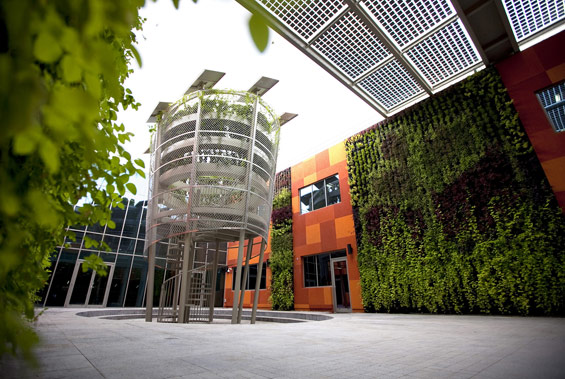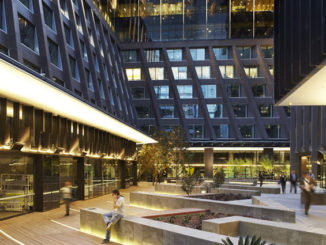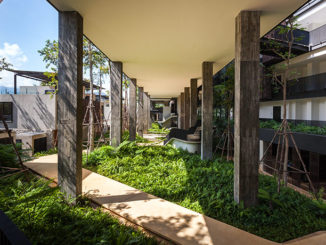Learning environments are constantly evolving to stay in stride with the world around us. The factors that influence how and where we choose to educate our future generation are many. With the pace of the world’s technological innovation, and the increasing level of convenience and distraction it provides, there is a realistic concern that people, kids especially, risk losing a tangible connection and respect for the natural world. As a landscape architect, being asked to shape an educational environment, the first responsibility is to create a healthy, safe and inspirational setting. Secondly, it is an opportunity to bring the natural world out of the background, and back into focus in a fun and inspiring way.
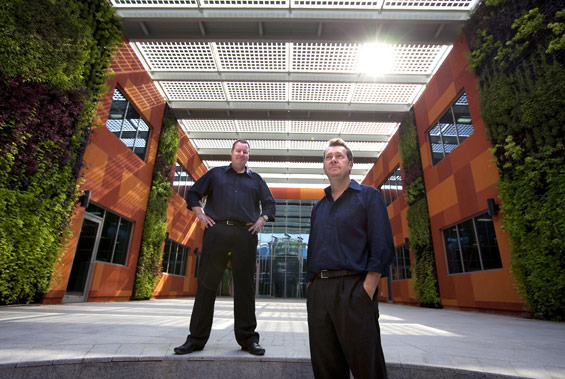
It was clear at the beginning of the design process that the Abu Dhabi Education Council (ADEC) endeavored to create something forward thinking, progressive and special for the children of Abu Dhabi, making a departure from institutional and architectural norms. It was also clear that an efficient and functional landscape would be a key part of the educational experience they aimed to create. In typical institutional settings, the landscape is often just used as a backdrop or to help create a scene. But at the Mubarak Bin Mohammed School in Abu Dhabi, Broadway Malyan’s landscape architects have taken the resources that are poured into the landscape – the water, the planting, the maintenance – and used those to serve the children, the school and the learning environment as a whole, creating a multi-use, educational landscape.
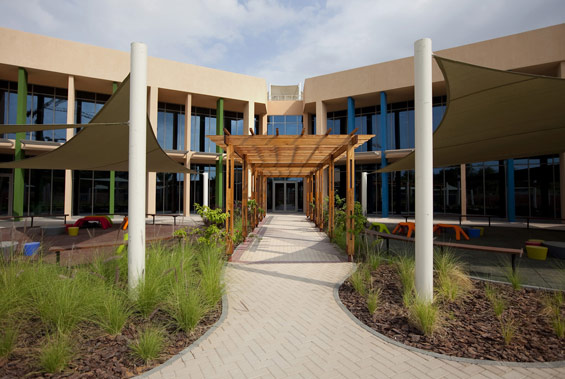
Any newly conceived landscape must respond to its own unique programme and context to be successful. Abu Dhabi presents an especially challenging context for creating a functional, educational landscape. Even though schools are not in session at the hottest times of the year, 3-4 months of the academic calendar are still impacted by extremely hot and humid conditions. It is important still to acknowledge and foster the idea that the learning environment extends beyond the walls of the classroom, and lessons shouldn’t be limited to indoors only.
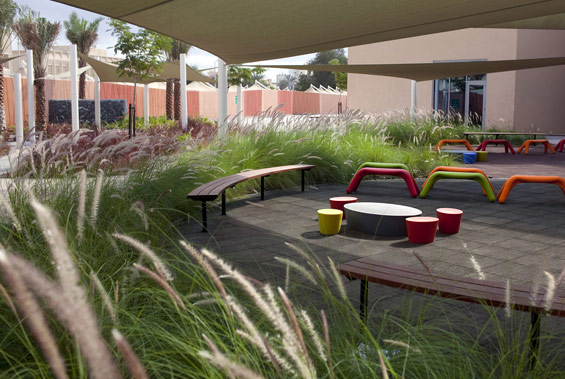
Local climate and cultural sensibilities have traditionally caused schools in Abu Dhabi to be quite enclosed and inwardly oriented. The Mubarak bin Mohammed School is noticeably more open and outward focused. In plan the school is composed of a single large building mirrored across a centerline to create a distinct division between boys and girls facilities. Tall date palms (Phoenix dactylifera) frame the entry and function to direct movement on site. The main entrance is marked by a deeply set glass façade creating a welcoming arrival. This feature alone immediately sets a broad-minded and inspirational tone to the whole scheme. External learning areas, play areas and sensory gardens spill out from the main building into multi-use landscaped plazas surrounded by a funky boundary wall. A generous outdoor “Eco-courtyard” unfolds at the heart of the school injecting life and allowing natural light to flood into the surrounding interior spaces while also acting as a flexible space and spill-out area for the labs, dining rooms and classrooms that surround it.
While the eco-courtyard space brings natural light into the building core, it also increases solar exposure potentially causing temperatures to sore, both inside and out. In order to mitigate these factors and to prevent this space from becoming dead, uninviting, and unusable, offering an appropriate mix of sun and shade is vital. Nearly every surface that casts shade into the courtyard is coated with photovoltaic cells that capture the sun’s energy, and direct it to the building to offset the overall energy consumption.
Beyond photovoltaic shading, the eco-courtyard features two separate vertical garden elements that enhance environmental comfort and offer additional opportunities for landscape-based learning. Living walls are set in niches on either side of the space, extending the full two-storey height of the courtyard. The vertical gardens are made from large PVC frames that contain hundreds of small nylon pockets, each of which holds a separate plant. Alternanthera spp., Portulaca grandiflora, Sesuvium portulacastrum, and Rhoeo discolor dominate, and a line of drip irrigation feeds off a single vertical mainline to water each horizontal row of plants.
The second vertical garden element of the eco-courtyard is a specialized steel structure we’ve dubbed the ‘Eco-tree’. This free-standing structure supports a vertical garden topped with photovoltaic panels for additional shading. The eco-tree is a fully interactive landscape structure accessible to the school children. The “tree” is one of the key spaces where outdoor lessons can take place. The intention is to encourage students to explore the practical benefits of learning to look after plants by seeing first-hand how they grow, are harvested, and recycled. We imagine part of the science lesson could be held within the eco-tree itself.
The planting in the vertical gardens and eco-tree actively demonstrate the important role that landscape, trees and plants can play in creating more sustainable urban environments. They help to clean and cool the air, improve humidity and provide shade in the courtyard. In doing so, they make a positive contribution to the performance of the building by helping to reduce the amount of energy it consumes.
Of all the positive roles for plants to play in the school, shade is the most important. Estidama, Abu Dhabi’s local sustainable development initiative, requires that 60 percent shade be provided to all outdoor gathering spaces and 75 percent to all pathways, and an additional 40 percent to all parking areas. This is a serious challenge from both a design and a budgetary perspective. However, this provides yet another opportunity to show what plants can really do. Trees provide a far better shading experience than do architectural shade structures. Trees mitigate the moisture in the air and cool the wind and breezes that flow through them. If you were to sit in an exterior courtyard under an architectural shade and then under a tree, the environment would be much cooler under the tree. A mature tree can actually provide as much as 20-30 percent more cooling than an architectural shade. This is vital to understand and creating a functional and inviting landscapes in the UAE.
The real power of the school’s landscape lies in a careful understanding of the site’s context and a thoughtful response this context through efficient use of landscape resources the make the exterior spaces more usable. In doing so the landscape does in fact emerge from the background, making a functional contribution to the daily lives of the people in the school. It moves beyond the ornamental and points to a future when the real value of the natural world is harnessed and recognized.
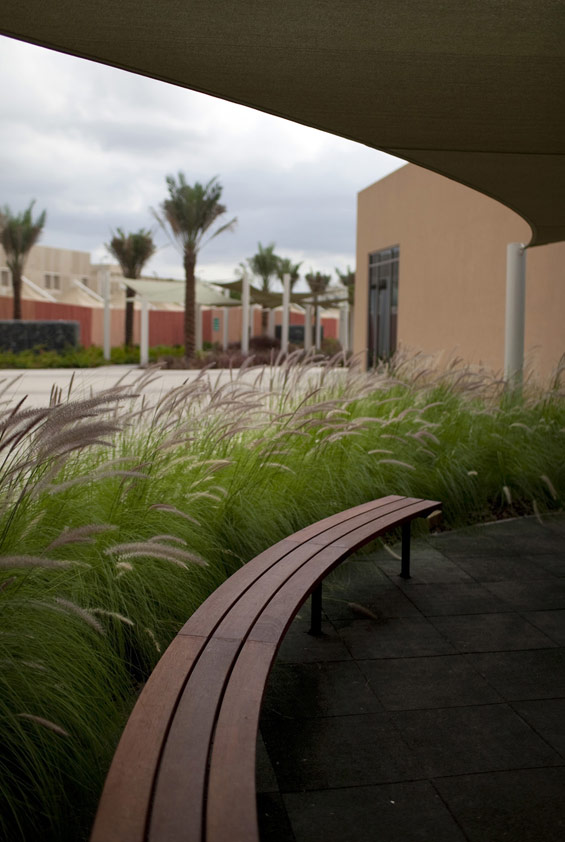
Text by Drew Kent, Landscape Architect at Broadway Malyan
Design Firm: Broadway Malyan
Architects: Nick Davies, Salim Hussain, Ben Somner, Alvaro Visier
Landscape Architects: Drew Kent, Beth L’Estrange,
News Article: Nick Leech / The National
Additional Text (below): Drew Kent / Broadway Malyan
Images: Silvia Razgova / The National

